Antec Three Hundred Two: Stay Cool, Budget Enthusiasts
by Dustin Sklavos on January 24, 2012 7:00 AM EST- Posted in
- Cases/Cooling/PSUs
- Antec
- mid-tower
Noise and Thermal Testing, Overclocked
Antec's Three Hundred Two put in a solid showing in our stock settings, but as you'll see, it's under the increased thermal load from our overclocked testbed that it really starts to come into its own. This is why enthusiasts on a budget will want to take note: long, long ago overclocking was about maximizing bang for your buck, and that's what Antec is aiming to do here.
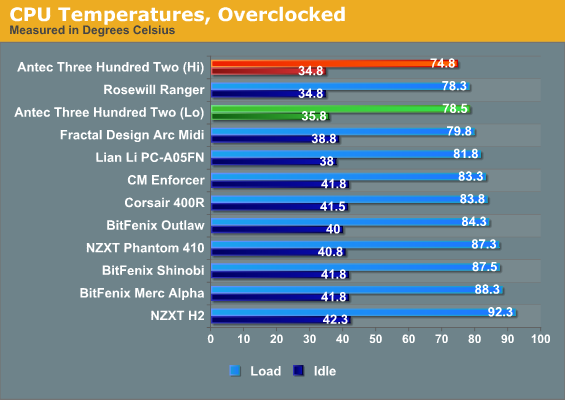

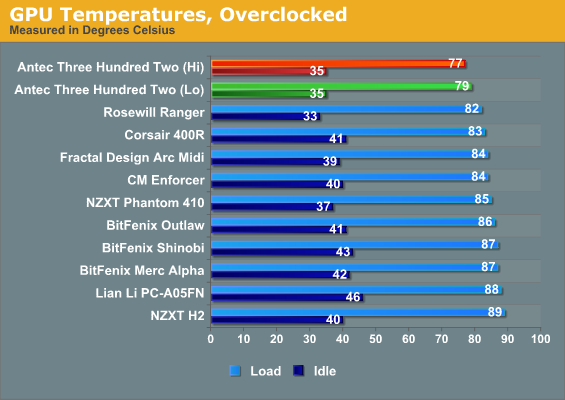
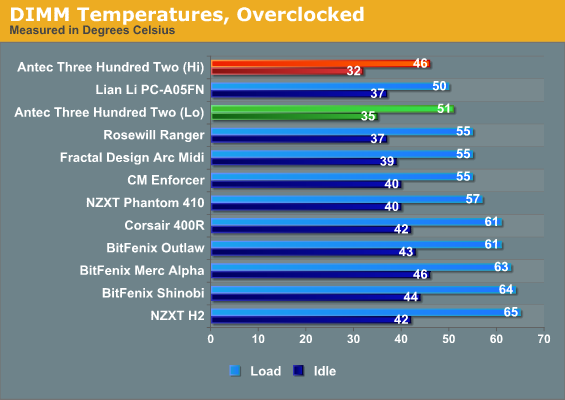
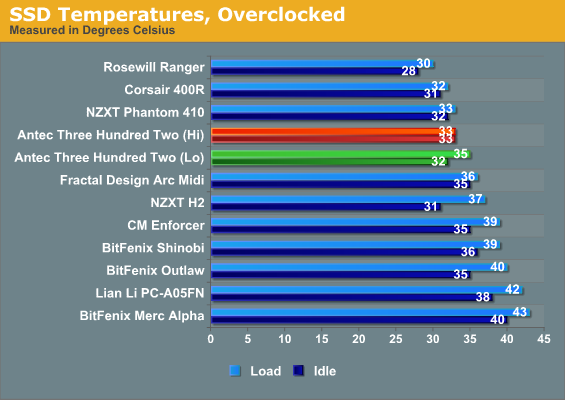
It's very nearly a clean sweep for Antec. The low fan speed continues to do a good job of keeping thermals down and idle CPU and GPU temps are among the best we've seen. The only test where the Antec doesn't place quite as high on the charts is in SSD temperatures, but anything south of 40C is more than adequate.
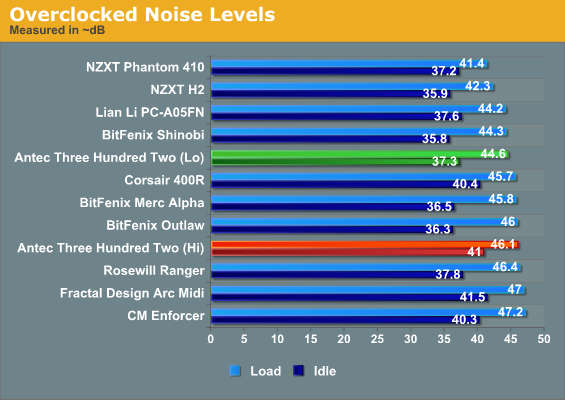
Of course, that performance comes at a cost. While idle noise isn't that bad at the low fan setting, the high fan speed is among our biggest offenders. The Three Hundred Two is an excellent performer, but you'll pay for it in noise. This is where all the ventilation in the sides and front comes into play, as it lets cool air in and hot air out, but unfortunately it doesn't do much to mask the noise of our test build.
Note that we are well aware of the difficulties of using a "one size fits all" testbed, but the real takeaway here is relative performance. We'll likely update to a more mainstream testbed after the Ivy Bridge launch, but whatever we choose as our baseline, there will always be other ways we could have customized for better cooling and/or lower noise levels.










50 Comments
View All Comments
piroroadkill - Tuesday, January 24, 2012 - link
What's the point? For the one person who has a Zalman Reserator still?That said, nice enough case, but my go-to case is still the Fractal Design Define R3. It just seems to do everything for everybody (as long as your graphics card fits), in a compact size, and sleek P180-esque design.
cjs150 - Thursday, January 26, 2012 - link
I love watercooling my rig but have never used the water cooling holes on any case.Even if I were to use the holes, the positioning on the Antec is just weird. Because the Antec is not too tall you could place a radiator on top of the case with fans actually in the case either pulling cool outside air through the rad and into case or pushing slightly warmer air (not as good but good enough most of the time) from case through radiator and out. Either way you would want the water cooling holes to line up with the inlets on the radiator - and they do not so you would have to mod the top of this case.
Is a bit of a shame because this could be a nice case to use for watercooling with a 240 radiator in front and on top - need to rip top off and remodel though.
I guess I will go back to the Arc Midi
bassetwrangler - Friday, January 27, 2012 - link
As a regretful former owner of a Zalman Reserator, I find it an obvious fantasy that there still exists even one functional example. I dismembered the over complicated carcass of mine, recycling as much as possible, so that it might never reconstitute itself once again into a worthless beeping nightmare.Death666Angel - Saturday, January 28, 2012 - link
I have a Silverstone TJ08-E and had to cut holes in the back myself (used the place above PCI brackets) because I use an external radiator mounted to the side of the case. A lot of people with high-end water cooling use external radiators with 3x3 120mm/140mm fans and need those holes. So there are good reasons for having them and usually they don't bother those who don't need them. However, here they are unfortunately placed very strangely and viewable. :-/doctormonroe - Tuesday, January 24, 2012 - link
I am not a fan of having fan holes behind the motherboard, I used to own a Thermaltake V9, which had such a feature and all it did was allow dust to accumulate on the back of the motherboard.Arbie - Tuesday, January 24, 2012 - link
A case vent behind the motherboard is actually a good idea. Even if you don't put a fan there, it is one of the few places where a simple hole makes sense. Being shielded from the main cavity, it won't let much noise leak out. But air will find its way, and will circulate around much of the mobo perimeter and rear surface to get there.This assumes, of course, that you are running at least a slight positive pressure, which I think is the only sensible thing to do (see other posts). Otherwise you will get dust, as you note.
sajid - Wednesday, January 25, 2012 - link
this is reply to "Fan behind the motherboard tray" by Sajid at 11:41 AMBoogaloo - Tuesday, January 24, 2012 - link
I managed to get an original 300 for $30 through a rebate and sale lining up. Didn't need it at the time but figured cases don't go bad. Then USB 3.0 came out :/Taft12 - Tuesday, January 24, 2012 - link
Cases don't go bad thanks to devices like this!http://www.newegg.ca/Product/Product.aspx?Item=N82...
KineticHummus - Tuesday, January 24, 2012 - link
How can that supply usb 3.0? it uses a usb 2.0 internal connection...